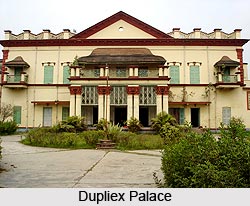 Religious and missionary activities of British was perhaps the first ever trace of English people landing in India, which was later to become a prolonged legendary association. However, until the renewal of the Charter Act of 1813, the British East India Company had blocked the entry of missionaries into India. With a clear vision, the Evangelicals now had access to India and could begin spreading the Gospel to the `idolatrous`, `heathen` Indians. The Church Missionary Society and the London Missionary Society joined the Baptist Missionary Society in the initial missionary efforts of translations of the Scriptures and the establishment of schools. Their efforts were built on the prior legendary work of the Reverend William Carey and the Baptist Missionary Society at Serampore. Vigorous efforts in evangelising and bazaar preaching brought only modest results, but enough to be seen as threatening to the Hindu culture and thus a contributing cause of the Indian Sepoy Mutiny of 1857. Following the Mutiny, the missionary focus rested on the use of educational and medical missions as vehicles for conversion. At the turn of the twentieth century, the fulfillment theory reigned for a time with the vision of Christianity as the next step, or as the fulfillment of Hinduism. Following the First World War, the established church separated from its British roots to become the Church of India and slowly its hierarchy became Indianised. In the end, Christianity held its greatest appeal among India`s untouchables. To sum up, British missionary and religious activities in India can be broadly classified and differentiated into four distinct phases, with separate facets, objectives and condition and status of Britishers in the nascent stage of capturing India.
Religious and missionary activities of British was perhaps the first ever trace of English people landing in India, which was later to become a prolonged legendary association. However, until the renewal of the Charter Act of 1813, the British East India Company had blocked the entry of missionaries into India. With a clear vision, the Evangelicals now had access to India and could begin spreading the Gospel to the `idolatrous`, `heathen` Indians. The Church Missionary Society and the London Missionary Society joined the Baptist Missionary Society in the initial missionary efforts of translations of the Scriptures and the establishment of schools. Their efforts were built on the prior legendary work of the Reverend William Carey and the Baptist Missionary Society at Serampore. Vigorous efforts in evangelising and bazaar preaching brought only modest results, but enough to be seen as threatening to the Hindu culture and thus a contributing cause of the Indian Sepoy Mutiny of 1857. Following the Mutiny, the missionary focus rested on the use of educational and medical missions as vehicles for conversion. At the turn of the twentieth century, the fulfillment theory reigned for a time with the vision of Christianity as the next step, or as the fulfillment of Hinduism. Following the First World War, the established church separated from its British roots to become the Church of India and slowly its hierarchy became Indianised. In the end, Christianity held its greatest appeal among India`s untouchables. To sum up, British missionary and religious activities in India can be broadly classified and differentiated into four distinct phases, with separate facets, objectives and condition and status of Britishers in the nascent stage of capturing India.
First Phase of Missionary Activities of British in India
The first phase of British missionaries in India falls within the time-period of 16th century to 18th century. This was the era, when the British East India Company was making its very initial voyages to broaden trade prospects with East. As such, to establish British colony in an alien country, it was necessary to know the countrymen primarily. Thus, Christian preachers and clergymen were sent to make Christianity a homely faith amongst the `heathens`. Englishmen were at times accompanied by French and Dutch missionary activists, who were later ousted in a warlike manner.
Second Phase of Missionary Activities of British in India
With the already established notion of Christianity in the first phase, second phase of British religious and missionary activities falls within the era from late 18th century to mid-19th century. The time witnessed the tremendous rise of Christian faith as a leading religion in India. Church was the foremost organisation, which became successful to achieve such a task. The British Crown from England had laid down certain rules also, for such earnest endeavours. The Presidency towns of Calcutta, Madras and Bombay were the key places, from where operations took place. The Holy Bible was also a religious initiator in this phase.
Third Phase of Missionary Activities of British in India
The third phase of British religious missionary activities in India comprised the years falling within mid-19th century till late-19th century to early 20th century. This was the period of the rise of the Indian intellectual and the middle-class educative class. They were also termed as reformists or nationalists. Armed with educative values, they understood the value of Christian faith, beliefs and conversion. Women were also noticed to have come up in such a socialist movement. Societies, schools, hospitals, churches and specialised homes were established by the still broad-hearted English. Then came the incredible resisting force of Sepoy Mutiny of 1857, hampering religious activities to the maximum. After the Mutiny, things took a dramatic turn, never to remain the same again.
Fourth Phase of Missionary Activities of British in India
Fourth phase of the missionary and religious activities in India by the Britons lasted within the period of early 20th century till Indian Independence. The corrosive, resisting and rebellious era had set in. British presence in India was no longer considered a boon, tremendously hindering religious activities in the way. Though Her Highness in England had formulated regulations to make Indians calmer towards English rule, yet, it was impossible under severe oppression. As such, Christianity was targeted as the foremost instigator to such motions. Churches were separated from the Government of India into a separate organisation; schools in the Westernised mode of education functioned violently, however without much result. Though in the times of Independence India was declared a secular country, yet missionaries of the 16th century failed to keep their notion strong in 1947.



















